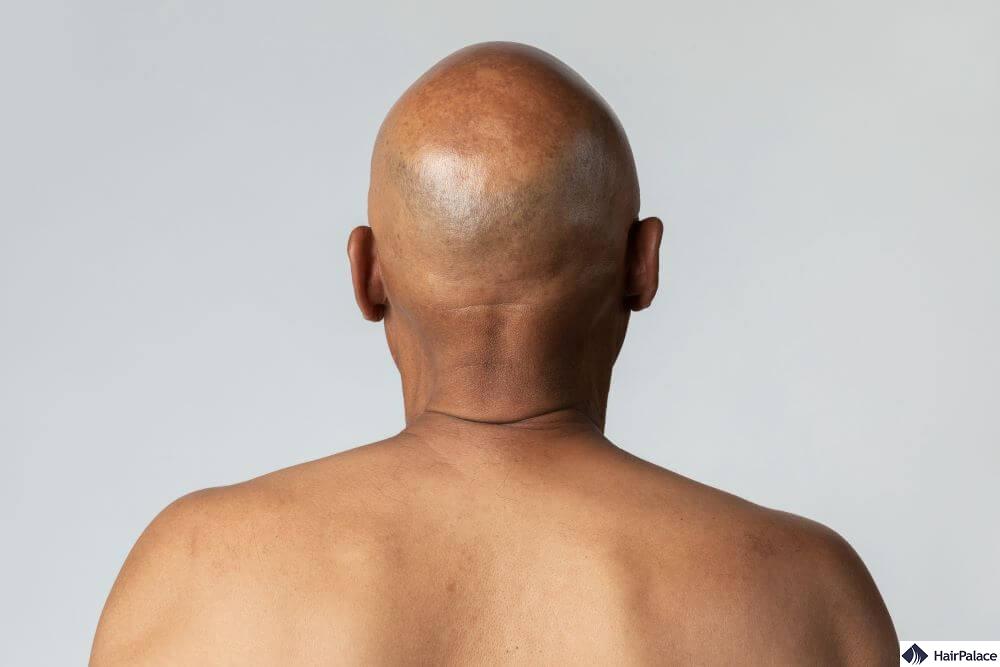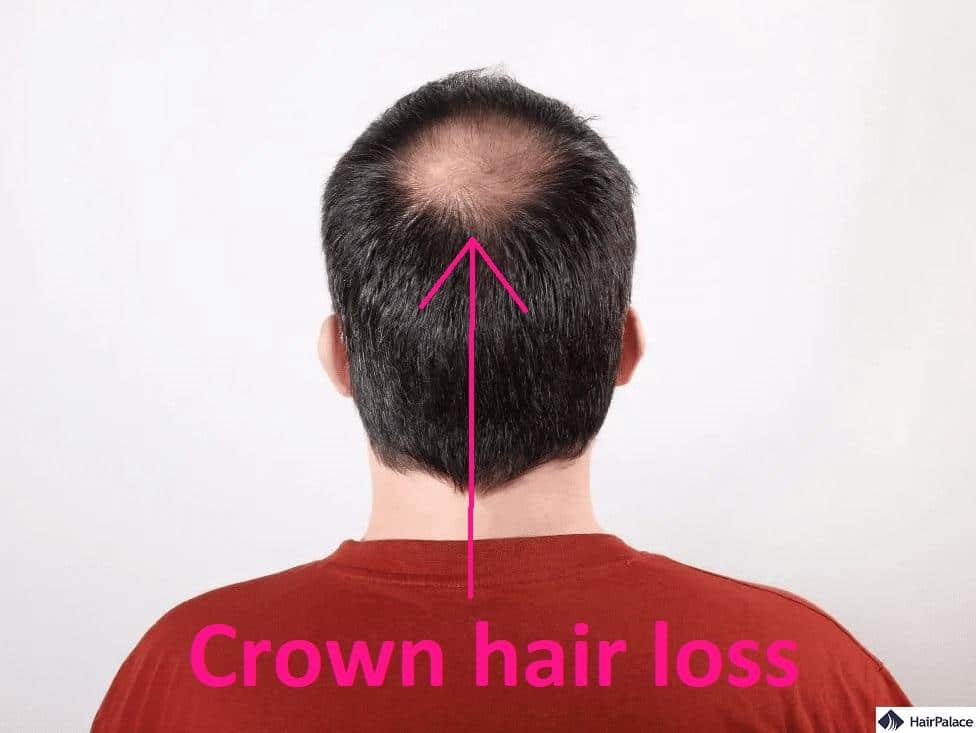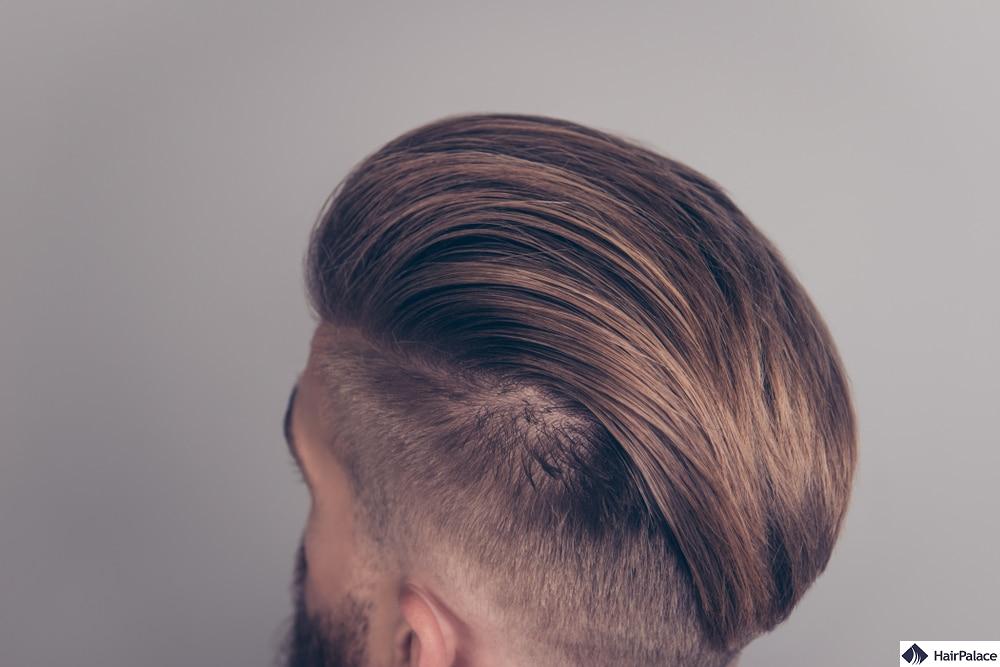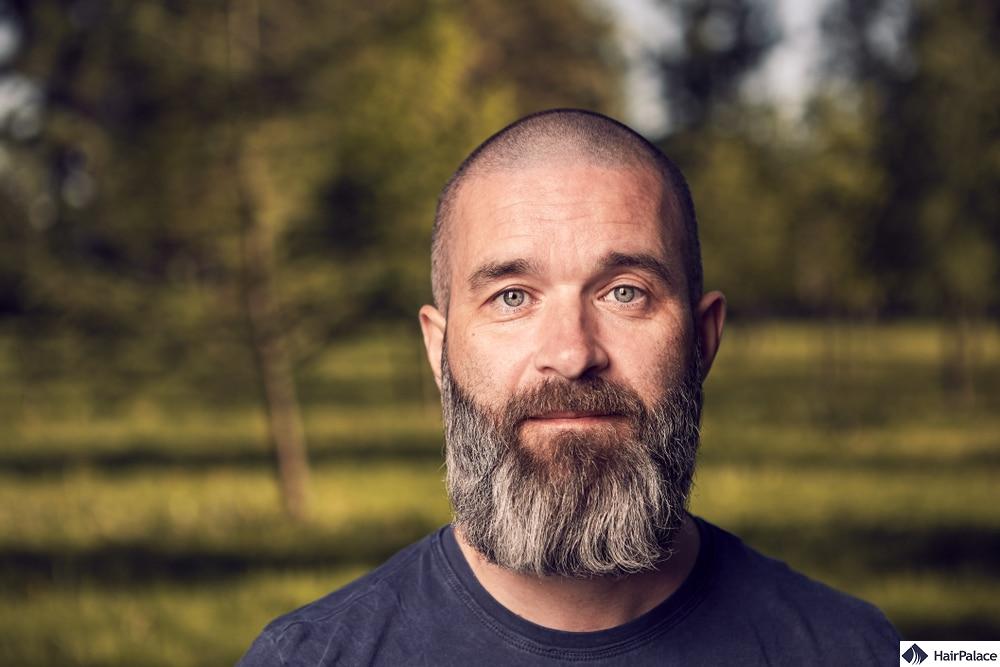Bald Spot on Crown: How to Spot & Stop it

A bald spot on the crown is a common form of hair loss where thinning occurs at the top of the scalp.
This type of hair loss is typically a result of androgenetic alopecia, influenced by genetics and the hormone dihydrotestosterone (DHT).
Treatment options include topical treatments like minoxidil, oral medications like finasteride, and surgical procedures such as hair transplants.
But are you guaranteed to go completely bald? Is there anything you can do to stop the hair thinning? And what’s the best way to hide your thinning crown?
Keep reading as we address these and other questions to help you manage your bald spot effectively.
- Is crown hair loss normal?
- What causes bald spots?
- How to prevent crown baldness
- Best way to hide your bald spot
- Solution for a balding crown
Is a bald spot on crown normal?
A bald spot on the crown isn’t considered normal, in most cases it’s one of the earliest signs of male pattern baldness.
That doesn’t mean you’re destined to lose all the hair on top of your head, but it does indicate that you’re likely to keep shedding over time.
Other early signs of male balding may appear alongside or instead of a thinning crown, such as a receding hairline.
What are the early signs of balding crown?
The early signs of crown hair loss include increased scalp visibility, a widening part line, weaker and finer hair, and increased hair shedding.
Difficulty styling due to reduced volume, increased scalp sensitivity, and slower hair growth are also key indicators.
Balding can be challenging to notice as the early signs are often very subtle.
The final sign is typically a small bald spot on crown which slowly gets bigger over time.
How to spot a bald spot on crown
Hair loss at the crown is the most obvious early sign of a bald spot.
To detect early signs of crown thinning, start with regular self-examinations using a hand mirror and a bathroom mirror to check for increased scalp visibility or uneven hair density.
Taking monthly photos under consistent lighting can also help track changes in hair density over time.
Pay close attention to hair shedding, especially in the shower drain, or on your pillow, and look for shorter, finer hairs falling out, which could indicate follicle miniaturization.
Sometimes, an outside perspective can be helpful, ask others if they’ve noticed any changes in your hair’s thickness or volume.
Additionally, comparing old photos from one or two years ago can reveal gradual thinning that might not be immediately noticeable.
What causes bald spots on the crown?
A balding crown, and androgenetic alopecia, tend to be caused by the hormone DHT.
This is responsible for the development of male characteristics, such as a deepening voice and body hair.
However, DHT can lead to problems when it adheres to androgen receptors in hair follicles on the scalp and causes them to shrink.
New hairs will be finer and more prone to shedding.
DHT can also reduce the length of the anagen phase of the hair growth cycle and increase the duration of the telogen phase.
New hairs will take longer and longer to grow back — until they stop growing altogether.
Hair on the back and sides of the scalp is more resistant to DHT, which is why these areas remain unaffected.
Male pattern baldness is typically hereditary from the paternal or maternal side, so if either (or both) of your parents have thinning hair, it’s possible that you will too.
Other potential causes
Male pattern hair loss is not the only condition that may lead to a bald spot on crown.
Other potential causes of a balding crown include:
- Traction alopecia – Prolonged stress on the follicles usually from over styling
- Trichotillomania – Pulling at your own hair, often without even realizing it
- Alopecia areata – Your immune system mistakenly attacks your own hair follicles
- Telogen effluvium – Excessive stress may lead to this type of hair loss
- Overstyling – This may mean damage from heat tools or chemicals
- Medical therapy – Certain medications may have side effects that lead to hair thinning
- Nutritional deficiency – A lack of nutrients can often prevent hair regrowth
- Hormonal imbalance – This can easily disrupt the natural hair growth cycle
- Illness – Illneses are among the most common causes of bald patches
- Trauma – A shock or trauma may cause permanent damage to the follicles
With so many different potential causes, it is always best to get yourself checked be a medical professional who can accurately diagnose the underlying cause of your crown hair loss.
How to prevent hair thinning at the crown?
To prevent hair thinning at the crown you must first be aware of the problem.

You’ll probably notice a gradual change as you lose hair in this area, primarily when running your fingers through it or when applying a styling product.
It may be impossible to stop crown hair loss from spreading across the scalp, especially if you have hereditary hair loss.
This condition causes varying degrees of hair loss and may lead to complete baldness on top of the head.
However, you can try certain techniques to stop a bald spot from spreading and reduce its visibility:
1. Avoid permanent hair loss: Groom your hair with care
You might have no idea how to cut or style your hair when you spot balding on your crown.
You could feel tempted to let your hair grow as long as possible to create the illusion that you have more of it than you do.
Or you may take the reverse approach and shave your hair off entirely.
But you must think carefully about how you want to handle your hair when a bald spot appears.
For some men, it’s not a big deal: they’ll keep styling their hair as they always have and accept this change as part of their ageing process.
Others, though, will find it much harder to deal with. And if you fall into that category, speak to your barber or stylist about your options to hide hair loss.
They may be able to recommend a cut or styling technique capable of masking your hair loss.
2. Use quality hair care products to prevent further hair loss
Do you read the ingredients in your hair care products before you buy them?
Or do you grab the cheapest items on the shelves and use them without checking what you’re putting onto your scalp?
If you answered “yes” to the second question, it’s time to start researching your hair care products.
Here are a few ingredients to watch out for:
- Sulfates: These attach to sebum on the scalp and can damage the follicles, strip away the hair’s natural oils, and leave the hair dry. Sulfates may also make eczema worse and irritate the skin.
- Formaldehyde: This is a known carcinogen and can be absorbed into the body via the skin. You can find this in certain shampoos, so if you see it listed on a label, put the bottle back on the shelf.
- Alcohol: Brands add alcohol to hair care products to help retain moisture, but it can dry and damage the hair.
- Polyethylene glycol: This ingredient is often added to hair care products as a thickening agent, but can strip natural moisture from the hair.
Anything that dries the hair out and potentially harms strands could exacerbate your hair loss.
Try to use products that contain natural ingredients to reduce the amount of synthetic substances coming into contact with your scalp and hair.
Consider asking other people with a bald spot on crown to recommend products that are kind to the skin and hair.
3. Regrow your hair with medication
Certain medications are designed to treat hair loss and encourage hair growth, but results can be mixed:
- Minoxidil: A topical treatment applied to the scalp, though you need to keep using it continuously to maintain results.
- Finasteride: An oral medication that reduces DHT levels in the body to stimulate hair growth. Again, though, continuous use is required.
How to hide bald spot on crown
If you’re self-conscious about speaking to your hairstylist about hiding your bald spot, don’t be.
They’ve probably already done the same for many other customers, and they’ll continue to do so long after you leave their salon.
An experienced stylist should be able to present you with a variety of ways to disguise the bald spot on your crown.
But if you want some ideas to suggest next time you’re in the chair, here are several great ones to consider:
Sleek pompadour

The sleek pompadour is a traditional hairstyle that’s still hugely popular today.
It’s ideal for masking a bald spot on the crown, as the hair is brushed away from the front of the scalp.
A pompadour adds height to the face and complements a neat beard brilliantly.
Just make sure you go easy on the product — too much may leave the hair too wet and still make the bald spot visible.
Side swept medium style

A side-swept medium style is terrific if your crown is the only thinning area on your scalp.
You can grow your hair longer and wear it to the left or right, covering the spot partially.
Buzz cut

People may be less likely to notice the bald spot on your crown if the rest of your hair is cut close to the scalp.
Plus, this bolder cut can also suggest that you’re confident enough with your hair loss to own your bald spot!
Classic slicked-back style

This is similar to a pompadour but the hair is kept shorter, for a sophisticated, classic look.
Caesar cut

The Caesar cut is a simple but incredibly stylish option for any man, even if you have a balding crown.
The hair is cut close to the scalp around the back and sides while retaining a heavier, textured section on top.
How to fix bald spot on crown
A hair transplant on the crown is the most effective way to restore hair, and it can address any other areas of the scalp affected by hair loss.
The latest hair transplants are available at incredible hair restoration costs, so they’re more accessible than ever.
An FUE treatment involves harvesting healthy hair follicles from the back and sides of the head and implanting them into the bald spot(s).
If you want to discuss a hair transplant with an expert team, contact HairPalace today!
However, if you want to avoid surgical intervention, you have other options.
Minoxidil is a non-surgical alternative, a topical solution that stimulates hair follicles and prolongs the growth phase.
Finasteride is a pill that blocks DHT, the hormone responsible for hair follicle shrinkage, helping to slow or reverse hair loss.
Additionally, low-level laser therapy (LLLT) improves blood circulation and cellular activity in the scalp, promoting hair regrowth.
Lastly, PRP (Platelet-Rich Plasma) therapy, scalp microneedling, and DHT-blocking shampoos can enhance follicle health and encourage regrowth when used consistently.
FAQ
A bald spot on the crown of the head is incredibly common. Men and women may lose hair in this area, even if the rest of their scalp remains unaffected.
Minoxidil (sold as Rogaine and numerous generic options) is one of the most popular and tested treatments for hair loss. You can try this as a foam, shampoo, or liquid. You may be able to try a stronger product with a prescription. However, it can trigger side effects such as irritated skin or undesirable hair growth close to the scalp.
Hair on the crown may regrow if the follicles remain intact and unaffected by DHT (a sex hormone that clings to follicles and shrinks them over time). Thinning hairs may also be treated to improve their condition.
Baby hairs are not necessarily a sign of balding. They are short, fine hairs around the hairline that everyone has. However, changes in their appearance can be related to various hair situations, but by themselves, they are not an indication of balding.
Hair thinning is often one of the first signs of balding in men.
Dry hair by itself is not a sign of balding. However, you should aim to nurture your hair shafts if you want to prevent hair damage.
Last medically reviewed on March 13th, 2025
- D.H. Rushton, I.D. Ramsay, M.J. Norris, J.J.H. Gilkes, Natural progression of male pattern baldness in young men, Clinical and Experimental Dermatology, 1991 May:16(3): 188–192,https://doi.org/10.1111/j.1365-2230.1991.tb00343.x
- Ellis JA, Sinclair RD. Male pattern baldness: current treatments, future prospects. Drug Discovery Today 2008;13(17-18):791-797https://doi.org/10.1016/j.drudis.2008.05.010
- Bernstein RM. (2017). Classification of hair loss in men.https://www.bernsteinmedical.com/hair-loss/men/classification/
- Hamilton J.B. Male pattern hair loss in man. Ann NY Acad Sci. 1951; 53: 708-728https://www.cidjournal.com/article/S0738-081X(00)00128-0/fulltext
- Rathnayake D, et al. Male androgenetic alopecia. 2010https://doi.org/10.1517/14656561003752730
- York K, Meah N, Bhoyrul B, Sinclair R. A review of the treatment of male pattern hair loss. Expert Opinion on Pharmacotherapy. 2020;21:5, 603-612.https://doi.org/10.1080/14656566.2020.1721463

